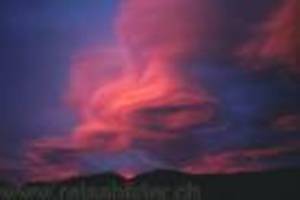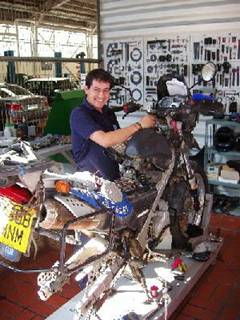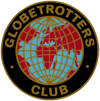 Trip
duration: 56 days
Trip
duration: 56 days
Trip miles to date: 5,632
Miles since last update: 472
Having completed over 5,600 miles in the previous 5 weeks, these
past two weeks have been frustratingly static as I've waited
for the Beemer to complete its rest and recuperation courtesy of
the BMW dealership in Santiago. Having sampled a lot of wine,
I've visited probably every museum in Santiago and spent a
long lazy weekend in Valparaìso I'm definitely ready to get
moving again.
 I'm also sad to
report that shortly after I left the Torres del Paine national
park an intense forest fire broke out which has now been burning
for 3 weeks. Over 14,000 acres have been destroyed and wildlife
has fled from the area and the entire park closed in what was
peak season.
I'm also sad to
report that shortly after I left the Torres del Paine national
park an intense forest fire broke out which has now been burning
for 3 weeks. Over 14,000 acres have been destroyed and wildlife
has fled from the area and the entire park closed in what was
peak season.
The fire was started by a Czech tourist who knocked over his
stove whilst illegally camping outside the official boundaries,
trails and designated camping areas – after a fine of US$200 he
was allowed to leave the country. Significant attempts to teach
visitors the perils of fire were plastered all around the park
when I was there and the stupidity of the Czech made national
news.
Ruta 5 up from Temuco was a 2 lane, blissfully smooth, tarmac
road all the way to Santiago. In fact Ruta 5 is the major artery
that runs the length of Chile from the tip of Chiloe in the south
to Arica, on the border with Peru in the north – a distance of
some 1,600 miles and is probably better known as the Panamerica
highway.
Although this is not highway in the English sense of the word.
Even for the stretch leading to Santiago, you should think less
M25 and more like a medium size A-road. The speed limit is 120
kph (75mph) although most vehicles seem to interpret this as
“as-fast-as-this-vehicle-will-allow” and speed
differentials vary greatly.
Another notable feature is the volume and bravery of pedestrians.
The entire length seems to harbour life like a coral reef as
towns and villages straddle the road. Locals seem to appear from
all directions and fearlessly cross the road in the face of
onrushing traffic. Strangely I saw a woman, carrying 2 small
children, struggle over the raised central reservation (rather
than use the raised pedestrian walkway installed not more than 50
metres away).
My initial view of Santiago was breathtaking and surprising.
Having spent many weeks in the wilderness of Tierra del Fuego and
Pategonia the mere sight of a huge, sprawling city containing
millions of citizens was surprising. My initial impressions of
Santiago were of a warm, friendly and generally happy capital. In
fact I felt more comfortable than Buenos Aires – I'm not sure
if this is a reflection of the comparable characteristics of the
2 cities, or the fact that I'm more conditioned to South
America after nearly 2 months.
One first task was to collect a package sent from Touratech –
being a replacement lid to the pannier box and various other
parts. Rather than deliver them to the hotel, DHL left me a note
requesting I pick up the package from the airport (thanks!) as
the goods exceeded the US$500 limit on imported packages. After I
pointed out that the only reason it exceeded US$500 was because
they had forgotten to omit the US$400 freight costs they conceded
I could collect the package after I paid a further US$200 import
taxes.
I struggled to keep my temper after I pointed out that US$200
taxes on goods worth no more than US$150 could not be right. It
frustratingly took me 4 hours to persuade DHL and custom officers
(including opening up the package) that taxes were not due and I
could leave the airport with the parts. As a piece of luggage,
the price is comparable to anything Louis Vitton ever put out but
it has bought me piece of mind and will make life easier.
The ride up took me through the prime wine-growing real estate of
Chile. After depositing the Beemer with the (only) BMW garage in
Chile I rented a pick-up and headed back down the road to tour
the area and sample some of the produce. The quality of the wine
belies its price and the Carmenère grape (unique to Chile) has
become a favourite.
After 3 of the 4 days had passed I quickly appreciated that they
would need at least another week (waiting for parts) so I hired a
car and drove to Valparaìso, the historic port town about 60
miles to the west.

Rather ungainfully tacked onto
the side of Valparaìso is Vinà del Mar. Whilst Valparaìso is a
busy commercial port full of historical buildings, busy market
places and rickety old carriages that ascend the surrounding
hills to the residential areas Vinà del Mar is full of bars,
restaurants, modern shopping malls and beach side holiday
apartments for wealthy Chileans.
After 4 days of wandering around the raised walkways and
picturesque alleyways of Valparaìso and 1 day sitting on the
beach in Vinà del Mar I returned to Santiago to check on progress
of the Beemer. Good news and bad news awaited me.

The bike was still 3 days away from being finished but they had
discovered a holed radiator (explaining an overheating issue on
the road into Santiago) and a burnt-out wiring loom where the
heated grips had shorted following the crash in Argentina. The
fork seals had arrived and were being fitted as I visited and as
I write this I expect to pick up the bike this afternoon – after
depositing an unfeasibly huge amount of money with the garage.
These past 2 weeks have moved incredibly slowly, the bike (and I)
are back in good shape to tackle the demands of the Atacama
desert and onwards to Bolivia and the Salar de Uluni.
If you want to know more about Greg's travels, visit his
website at: http://www.unbeatentrack.com/

 Trip
duration: 56 days
Trip
duration: 56 days
 I'm also sad to
report that shortly after I left the Torres del Paine national
park an intense forest fire broke out which has now been burning
for 3 weeks. Over 14,000 acres have been destroyed and wildlife
has fled from the area and the entire park closed in what was
peak season.
I'm also sad to
report that shortly after I left the Torres del Paine national
park an intense forest fire broke out which has now been burning
for 3 weeks. Over 14,000 acres have been destroyed and wildlife
has fled from the area and the entire park closed in what was
peak season.



 We are sorry
to say that Mac is not very well, but he is still e-mailing
strong and recently sent the Beetle a collection of travel
reminiscences.
We are sorry
to say that Mac is not very well, but he is still e-mailing
strong and recently sent the Beetle a collection of travel
reminiscences.